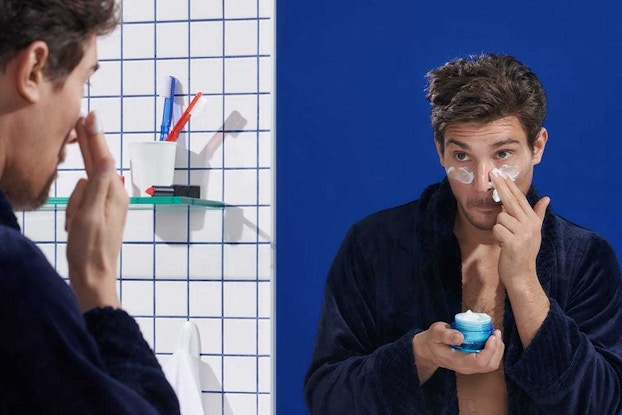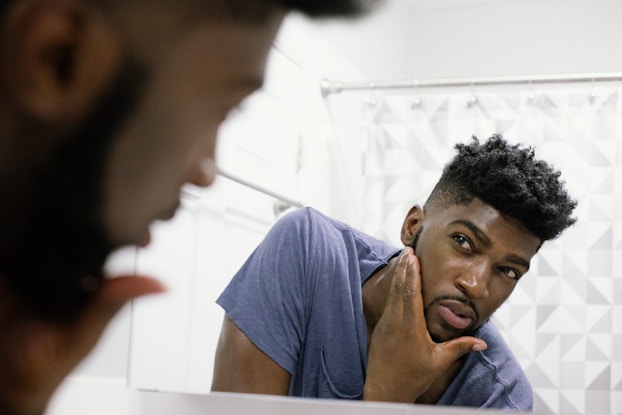
Once upon a time, it was easy to distill the men’s grooming category into a single aesthetic: manly. There is change afoot, however, and female consumers are no longer the industry’s only focus.
“It's almost as if they were given permission to outwardly care about the shape of their skin, hair, and bodies,” Michael Fisher, vice president of menswear and culture at trend forecasting firm Fashion Snoops, tells CO—, emphasizing the role of social media. “Being such a voyeuristic society [has] brought down a lot of walls around personal preferences about things like wellness and grooming.”
Forecast to reach $166 billion by 2022, the men’s personal care market represents a major opportunity for brands willing to evolve along with their consumers.
Beyond the 3-in-1
Traditionally, “male” beauty products featured packaging that was usually red, black or blue, with strong fonts and aggressive branding; products themselves were designed to solve many problems at once, best illustrated by the much-maligned 3-in-1 shampoo, conditioner and body wash concept.
Today, it’s clear that there is no one definition of “men’s beauty,” which presents both a challenge and an opportunity for brands to unlock the market’s untapped potential.
“The advent of the internet has enabled male consumers to learn more about their own needs and preferences and search out appropriate products,” reports Euromonitor International. As a result, men are looking for solutions personalized to their own needs, rather than settling for one-size-fits-all options, and are considering the overlap of grooming and wellness to develop new self-care routines.
“We need more innovation in the space, and we also need to meet consumers where they are in their own masculine journey, whatever that may be,” says David Yi, founder and editor-in-chief of Very Good Light, a digital beauty platform for men.
To Yi, a flood of new direct-to-consumer brands are jockeying to truly stand out in an increasingly crowded field, which is now populated by mainstream success stories like Harry’s and Dollar Shave Club. The most unique startups, Yi says, are those that deliver convenient solutions while tackling stigmas around sensitive health and wellness issues, such as hair loss and erectile dysfunction.
“The [direct-to-consumer] space is getting very crowded, which is a great thing for the consumer,” Fisher adds. “But in order to succeed going forward, I think they'll have to offer up something more than just basic moisturizing. They'll need a niche angle that addresses a very specific need, or a customer who may not be finding what he needs at retail.”
Both Hims and Roman, which began as telehealthservices for men, have since added new categories like skincare and health supplements, as well as expanded into women’s healthcare with Hers and Rory, respectively.
Indeed, niche brands are gaining steam in the men’s personal care space, and helping the category to meet the unique needs of the long-underserved minority consumer. The success of DTC pioneer Bevel, launched in 2013 as a shaving brand for men of color, exemplifies the evolution of the grooming market. The brand, led by entrepreneur Tristan Walker, has since expanded into a full range of personal care products and was acquired by Procter & Gamble in 2018. Buoyed by its new funding, Bevel plans to expand its nationwide distribution tenfold over the next year.
Men just want good products that give them results.Michael Fisher, vice president, Fashion Snoops
Disrupt
These men's grooming companies have realized a market of untapped potential. Read on for more companies who have successfully disrupted their industries.
Prioritizing shopper education
For men with little to no experience in shopping for beauty and skincare, the category presents quite a steep learning curve. Mainstream retail spaces like Sephora, Ulta or the department store beauty counters are — whether intentionally or not — often designed with female shoppers in mind. Rather than rely on the women in a man’s life to educate him around beauty and skincare, brands and retailers are evolving to create an environment where male shoppers can feel comfortable asking questions and learning the basics themselves.
Without an abundance of retail locations designed for male shoppers to visit in person, it’s up to brands and online platforms to do to the work of educating new customers. “This is where learning and education comes into play,” says Heather Ibberson, analyst with retail data platform Edited. “It is important for brands to show customers how to confidently use their product to inform future purchase decisions.”
Huron, a skincare basics brand that targets the entry-level grooming consumer, is notable among direct-to-consumer brands for its pursuit of the Middle American man. To entice men new to skin and body care, models on the site are diverse but recognizable to men across the U.S., and product offerings are streamlined for ease of use.
Brands like Asystem and Oars + Alps(recently acquired by SC Johnson for $20 million) help men to build new habits, using a subscription retail model to extend customer lifetime value. Asystem’s Performance Skincare kit encourages daily use and rewards monthly subscribers with a $10 discount over the one-time purchase.
Messaging around men’s grooming often emphasizes efficacy over style. Perhaps, at the end of the day, Fisher posits, winning over the results-oriented male consumer may be as simple as delivering a product that works. “I think they care less and less about how it looks on the store shelves,” he says. “Men just want good products that give them results.”

Beauty’s genderless future
As Gen Z, our most diverse and digitally native demographic yet, gets older and ages into spending power, traditionally gendered products will start to feel more and more dated, experts say. Unafraid to question the status quo or support only brands that espouse values similar to their own, younger consumers are driving an interest in ungendered products, even including color cosmetics and nail polish. According to a study by market research firm Morning Consult, 30% of Gen Z men surveyed were interested in or would consider using cosmetics.
“By and large I think there’s going to be more genderless beauty products, even cosmetics, hitting shelves in the next few years,” says Yi. “We need products that speak to a new generation, that aren’t so hyper-masculine in marketing or use. Younger people don’t want to be boxed in.”
Even retailers like Target have incorporated “genderless” into merchandising categories online, inviting male-identified consumers into traditionally female categories and acknowledging non-binary individuals.
Skin care brands Disco and Soft both reflect a new, softer masculinity, with branding that looks more like Glossier than Old Spice. Highlighting natural ingredients and Instagrammable, sustainable packaging, these brands hope to resonate with a new generation of digitally native skin care shoppers.
For those looking to explore color cosmetics, brands like Rihanna’s Fenty Beauty have created marketing content and shopping guides for the things men might need most: concealer, eyebrow gel, lip balm and the like.
“New millennial and Gen Z icons such as Harry Styles and Jaden Smith have been outspoken on subjects of gender fluidity and have contributed to the shift towards traditional feminine garments being featured in menswear fashion,” Ibberson says. “Male beauty looks set to become a normalized part of our mainstream culture.”
CO— aims to bring you inspiration from leading respected experts. However, before making any business decision, you should consult a professional who can advise you based on your individual situation.
Want to read more? Be sure to follow us on LinkedIn!
CO—is committed to helping you start, run and grow your small business. Learn more about the benefits of small business membership in the U.S. Chamber of Commerce, here.









